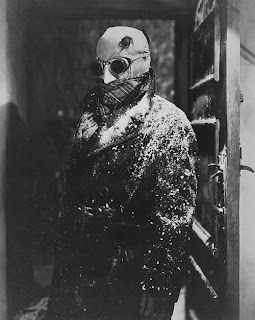James Whale, 1933
Starring: Claude Rains, Gloria Stuart, William Harrigan, Henry Travers
Somewhat loosely based on H.G. Wells’ novel of the same name, this blend of sci-fi and horror concerns mad scientist Dr. Jack Griffin, who has been experimenting with a forbidden drug known as monocane. He has discovered how to become invisible and takes a room at an English village inn to continue his research and figure out how to transform back. He enters the inn wearing bandages, goggles, and a heavy coat and attracts the attention of the proprietors, who refuse to leave him in peace. What Griffin doesn’t realize is that the monocane has an unexpected side effect: insanity. He nearly beats the owner of the inn to death and runs off into the night, disrupting as many locals as possible. They call the police, who at first refuse to believe there is an invisible man on the loose, but when he kills an inspector, the game is afoot.
Griffin breaks into the home of a colleague, Dr. Kemp, and insists they will work together to take over the world or he’ll kill Kemp. Kemp is horrified and contacts their mentor, Dr. Cranley, to talk some sense into Griffin and warn him about the brain-scrambling side effects of monocane. Cranley’s daughter Flora is in love with Griffin and is desperate to save him before it is too late.
Another magical film from director James Whale (Frankenstein, Bride of Frankenstein, The Old Dark House), The Invisible Man may be flawed, but plays to two of Whale’s greatest strengths. The first, special effects, are still impressive by today’s practical effects standards and were designed by John Fulton, who also worked on Bride of Frankenstein. The second is Whale’s ability to create a charismatic character who is villainous, but also full of whimsy. Like Dr. Pretorius in Bride of Frankenstein, Griffin is captivating lead. He is turned diabolically evil by the drugs he has experimented with, but throughout the film has an undeniable amount of whimsy, so much so that I can’t help but feel that he was an inspiration for the Joker. He laughs maniacally, sings songs to himself (the scene where he skips down a lane as a pair of disembodied trousers singing “Here we go gathering nuts in May” is one of the comic highlights of the film), derails trains for fun, robs a bank just to give away the money, pushes a few people off a cliff to their deaths seemingly out of boredom, etc. Griffin’s all too human malevolence is unlike any of the other Universal classic monsters and helps The Invisible Man remain more topical than some of its sibling films.
It is hard to believe that Claude Rains’ first major role mostly involved his disembodied voice or acting while covered in bandages and a dressing gown, but his powerful vocal skills helped propel him to fame. Though he was not the first choice for Griffin (this honor went to Boris Karloff, who turned the film down due to salary), he absolutely makes the film an enduring horror classic. Rains was not really a Universal regular like many of the actors to appear in their horror films, but he later starred in a Universal remake of Phantom of the Opera. He would become famous for such classic films as Casablanca, Notorious, and Lawrence of Arabia.
Unfortunately the supporting cast is not able to compete with Rains. Whale cast the abysmally annoying Una O’Connor (Bride of Frankenstein) who shrieks her way through the first quarter of the film, as well as Henry Travers (It’s a Wonderful Life) as Griffin’s likable but somewhat impotent mentor. Gloria Stewart (The Titanic), the love interest, is beautiful, but seems to have an emotive range limited to sad, whining, or distraught. William Harrington is a thoroughly unlikable and unsympathetic Kemp, though this was probably intended to make Griffin more sympathetic. Keep your eyes peeled for Universal horror regulars Dwight Frye (Dracula, Son of Frankenstein) and John Carradine (House of Dracula, Stagecoach) who also appear in side roles.
The Invisible Man’s primary flaws are its inability to decide what kind of film it wants to be. While Universal had this problem with many of their later mad scientist films that waver back and forth between horror and comedy, this was the first. The bevy of police officers are ineffective comic relief, again something Universal would suffer from in later series entries like Dracula’s Daughter. Though they don’t slow down the proceedings nearly as much as the dialogue, which is often laughable. The ending is also far less personal than it should have been, sort of rehashing the Frankenstein trope of a burning burn.
By far the strongest in the Invisible Man series, I have a definite soft spot for this film and recommend it to any fans of sci-fi horror. Though whole Universal series, though deeply flawed, is also pretty lovable. The Invisible Man was followed by The Invisible Man Returns, starring Vincent Price, the bizarre comedy film The Invisible Woman, the equally bizarre spy-suspense film Invisible Agent, and the laughably bad The Invisible Man’s Revenge, as well as many, many more film remakes, spin-offs, and TV series. The Invisible Man and its sequels are available as part of The Invisible Man: The Legacy Collection and the film itself is available as part of the new Universal Classic Monsters: The Essential Collection Blu-ray box set.


No comments:
Post a Comment